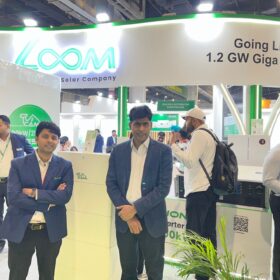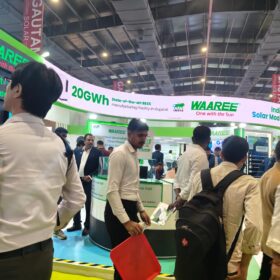Currently, India ranks third globally when it comes to energy consumption. While the per capita energy use is less than half the global average, this is set to change over the years as electrification continues to grow and growing economic prosperity drives Indian households to buy more power-hungry electrical appliances and vehicles. We have the technology today to power a significant portion of this electrified future with clean, affordable, and reliable energy from rooftop solar.
While a large chunk of India’s energy demand is currently being met by fossil fuels such as coal, this is not a sustainable option for the future. India’s energy policy is guided, to a great extent, by its commitments under the Paris Climate Agreement, 2015. Some of the key targets under this include reducing emission intensity by 33‐35% by 2030, as compared to 2005 levels. In addition to this, the plan is to increase the share of non‐fossil fuel-based electricity generation capacity to 40%, to achieve 450 GW of installed renewable capacity by 2030, with solar contributing about 280 GW (over 60%).
The Government has already taken several steps to facilitate this shift, including a stated focus on the use of cleaner fossil fuels, greater use of biofuels, rapid scaling up of renewables, electric mobility, and a shift towards emerging fuels including hydrogen. The government as well as corporates have been rallying behind the increased adoption of renewable energy. They are also pro-actively exploring the feasibility of adopting other new emerging renewable technologies such as storage, hydrogen, and geothermal which are driving energy innovation.
While solar power accounts for about 4% of India’s electricity consumption today, it is set to see exponential growth in the coming years. As per an assessment by the National Institute of Solar Energy, India has a solar potential of about 748 GW, assuming 3% of the wasteland area to be covered by solar PV modules.
We’ve seen an increase and transition in the use of solar energy in households, from solar water heaters to houses mostly dependent on solar energy. The following factors will influence the proliferation of solar in India over the next five years.
Focus on domestic solar manufacturing
India’s domestic manufacturing capacity in solar is not sufficient to fulfill the demand for the installation of 25 GW solar power capacity every year. In 2019-20, the import of solar wafers, cells, modules, and inverters amounted to $2.5 billion, as per data from the Indian Government. As solar adoption goes up, this number is likely to go up significantly.
Therefore, there needs to be a long-term policy in place to ramp up domestic manufacturing and reduce dependence on exports. Doing so will also create good-quality jobs all across the country, which, will, in turn, boost the overall economy.
Better grid management
The adoption of local, community-based energy solutions like rooftop solar and batteries can help make the energy grid more flexible and reliable. Home solar and batteries will enable the growth of ‘prosumers’ who produce and share energy, as well as consume it. Generating and using energy at the point it’s being used is also more efficient and reduces the need for big, centralized power often fueled by polluting fossil fuels. I’m encouraged to see the Indian Government taking steps to boost decentralized renewables and peer-to-peer (P2P) energy trading initiatives.
Solar electrification of villages
Local solar and battery solutions will also prove to be beneficial from the perspective of rural electrification. Since it is abundantly available, solar provides greater energy security in a rural scenario.
In addition, the Government of India’s plan to develop a ‘green city’ in every state of the country, powered by renewable energy will help take environment-friendly power to the mainstream. This will be achieved through initiatives such as solar rooftop systems on all houses, solar parks on the city’s outskirts, waste-to-energy plants, and electric mobility-enabled public transport systems.
In rural areas, efforts such as canal-top solar power plants, where irrigation canals are covered with solar panels, can offer an interesting alternative to rooftop solar.
To sum up
Solar energy in our communities and on our buildings helps people save money and reduces our overall reliance on polluting fossil fuels. It’s also creating good, local jobs through the installation of the equipment and the manufacturing of the technology. Let’s continue innovating and drive the transformation of our energy system one rooftop at a time.
The views and opinions expressed in this article are the author’s own, and do not necessarily reflect those held by pv magazine.
This content is protected by copyright and may not be reused. If you want to cooperate with us and would like to reuse some of our content, please contact: editors@pv-magazine.com.








Sir, your presentation is quite interesting & wonderful. Your assessment say that if we cover the 3% wasteland with Solar PV Modules then we can easily achieve the installation of Solar power plant of capacity up to 748 GW. Considering 17% CUF then we can generate around 1113921.6 MU which will be enough to meet out the commitment of GoI. But we should work on other important area like ho the power will be evacuate up to end user, present policies, infrastructure like transmission lines, mindset of peoples including requirement of skilled manpower. I would like to interact to you in future also
Solar power growth in real terms will be higher only when Quality Players in Private sector will carry out more awareness and do installations. The Discom s are not interested for reasons understood by most. It will be like telecom sector that people using Solar from Private entities as Vodafone, Airtel and later Jio made mobile services better. BSNL could never do such. Now Electricity is monopoly sector by State Government Utilities. But when people and institutions start independent installations and start getting services better then it will boom automatically. No Government or Public Enterprises can do that as they have lot of own issues.